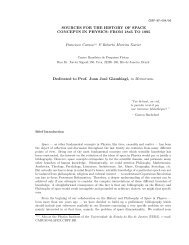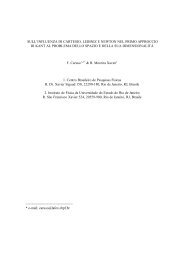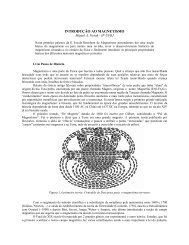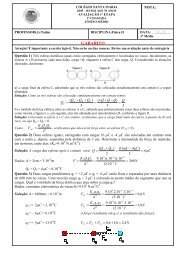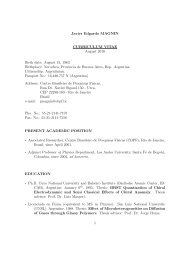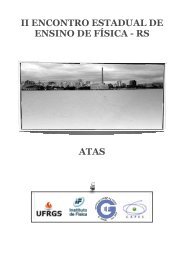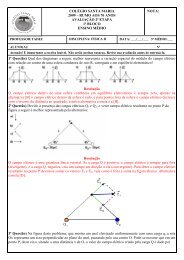Primordial non-Gaussianity in the cosmological perturbations - CBPF
Primordial non-Gaussianity in the cosmological perturbations - CBPF
Primordial non-Gaussianity in the cosmological perturbations - CBPF
You also want an ePaper? Increase the reach of your titles
YUMPU automatically turns print PDFs into web optimized ePapers that Google loves.
Let us emphasize a subtle dist<strong>in</strong>ction between <strong>the</strong> particle horizon and <strong>the</strong> Hubble: if particles are<br />
separated by distances greater than RH(t) <strong>the</strong>y never could have communicated with one ano<strong>the</strong>r;<br />
if <strong>the</strong>y are separated by distances greater than <strong>the</strong> Hubble radius H −1 , <strong>the</strong>y cannot talk to each<br />
o<strong>the</strong>r at <strong>the</strong> time t.<br />
We shall see that <strong>the</strong> standard cosmology <strong>the</strong> distance to <strong>the</strong> horizon is f<strong>in</strong>ite, and up to numerical<br />
factors, equal to <strong>the</strong> Hubble radius, H −1 , but dur<strong>in</strong>g <strong>in</strong>flation, for <strong>in</strong>stance, <strong>the</strong>y are drastically<br />
different. One can also def<strong>in</strong>e a comov<strong>in</strong>g particle horizon distance<br />
t<br />
τH =<br />
0<br />
dt ′<br />
a(t ′ ) =<br />
a da<br />
0<br />
′<br />
H(a ′ )a ′ 2 =<br />
a<br />
0<br />
d ln a ′<br />
<br />
1<br />
Ha ′<br />
<br />
(COMOVING PARTICLE HORIZON).<br />
Here, we have expressed <strong>the</strong> comov<strong>in</strong>g horizon as an <strong>in</strong>tegral of <strong>the</strong> comov<strong>in</strong>g Hubble radius,<br />
1<br />
aH<br />
(24)<br />
(COMOVING HUBBLE RADIUS), (25)<br />
which will play a crucial role <strong>in</strong> <strong>in</strong>flation. We see that <strong>the</strong> comov<strong>in</strong>g horizon <strong>the</strong>n is <strong>the</strong> logarithmic<br />
<strong>in</strong>tegral of <strong>the</strong> comov<strong>in</strong>g Hubble radius (aH) −1 . The Hubble radius is <strong>the</strong> distance over which<br />
particles can travel <strong>in</strong> <strong>the</strong> course of one expansion time, i.e. roughly <strong>the</strong> time <strong>in</strong> which <strong>the</strong> scale<br />
factor doubles. So <strong>the</strong> Hubble radius is ano<strong>the</strong>r way of measur<strong>in</strong>g whe<strong>the</strong>r particles are causally<br />
connected with each o<strong>the</strong>r: if <strong>the</strong>y are separated by distances larger than <strong>the</strong> Hubble radius, <strong>the</strong>n<br />
<strong>the</strong>y cannot communicate at a given time t (or τ). Let us reiterate that <strong>the</strong>re is a subtle dist<strong>in</strong>ction<br />
between <strong>the</strong> comov<strong>in</strong>g horizon τH and <strong>the</strong> comov<strong>in</strong>g Hubble radius (aH) −1 . If particles are separated<br />
by comov<strong>in</strong>g distances greater than τH, <strong>the</strong>y never could have communicated with one ano<strong>the</strong>r;<br />
if <strong>the</strong>y are separated by distances greater than (aH) −1 , <strong>the</strong>y cannot talk to each o<strong>the</strong>r at some<br />
time τ. It is <strong>the</strong>refore possible that τH could be much larger than (aH) −1 now, so that particles<br />
cannot communicate today but were <strong>in</strong> causal contact early on. As we shall see, this might happen<br />
if <strong>the</strong> comov<strong>in</strong>g Hubble radius early on was much larger than it is now so that τH got most of<br />
its contribution from early times. We will see that this could happen, but it does not happen<br />
dur<strong>in</strong>g matter-dom<strong>in</strong>ated or radiation-dom<strong>in</strong>atd epochs. In those cases, <strong>the</strong> comov<strong>in</strong>g Hubble radius<br />
<strong>in</strong>creases with time, so typically we expect <strong>the</strong> largest contribution to τH to come from <strong>the</strong> most<br />
recent times.<br />
future<br />
A similar concept is <strong>the</strong> event horizon, or <strong>the</strong> maximum distance we can probe <strong>in</strong> <strong>the</strong> <strong>in</strong>f<strong>in</strong>ite<br />
∞<br />
Re(t) = a(t)<br />
t<br />
which is clearly <strong>in</strong>f<strong>in</strong>ite if <strong>the</strong> universe expands a a ∼ t n (n < 1).<br />
14<br />
dt ′<br />
a(t ′ , (26)<br />
)




